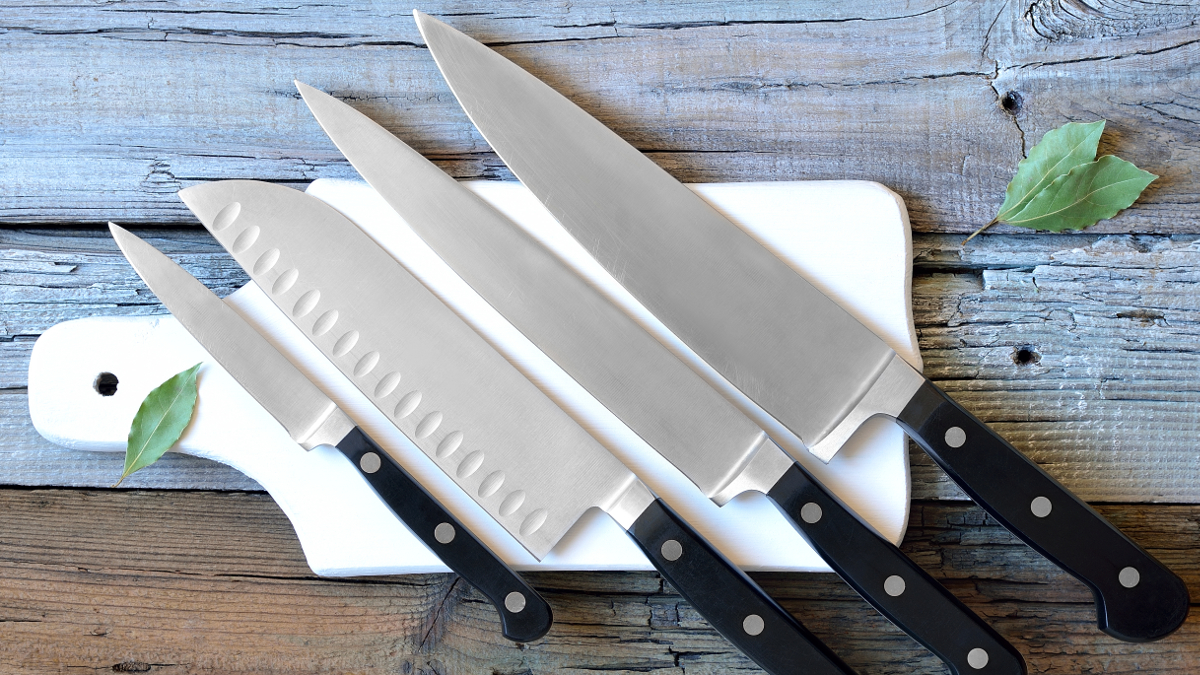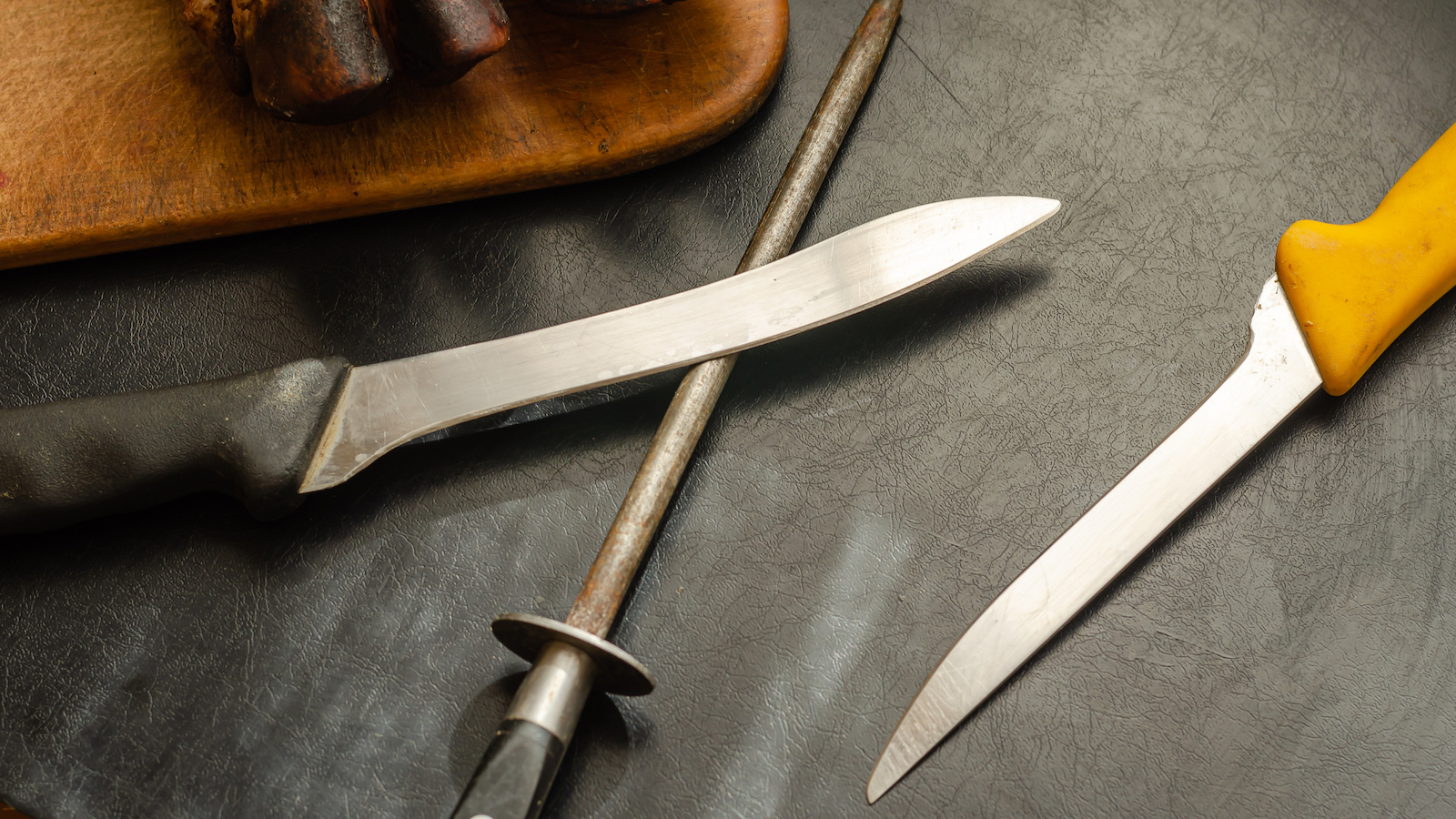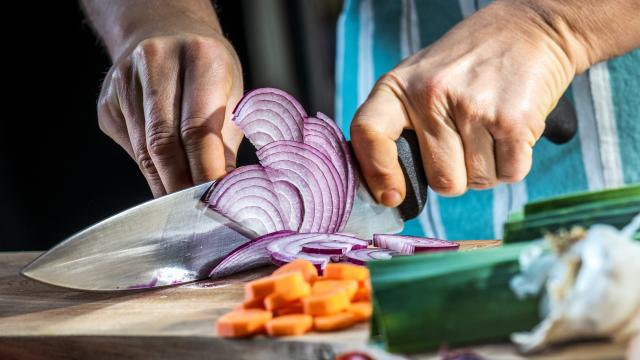It can be tempting to buy a knife set for yourself or for your mates as a cheeky housewarming gift, but I’m here to tell you, don’t do it. The money you spend on several subpar knives could be used to buy fewer knives of a much higher quality, which will actually last you well into the future if you treat them right. If your 2023 resolution is to be a bit more active in the kitchen, a good set of knives can go a long way when it comes to food prep.
To help you master the blade, here’s the run-down on why you should steer clear of cheap knife sets and what you should consider picking up instead.
Knife sets almost always mean terrible knives
When you’re first moving out on your own or setting up a kitchen, buying a set of knives can seem like a good idea. For a decent price, you can get a bunch of knives, a honing steel and a block to store them all in. Sounds good, right?
The problem with knife sets is that they’re almost universally terrible. We’ve touched on this a little bit before, but often manufacturers skimp on build quality, materials, size, and even blade geometry in order to produce a cheap product. They’re not designed to keep their edge in day-to-day use, to stand up to regular use or even sharpening, and dull knives can actually be a hazard.
The video above from the folks at America’s Test Kitchen actually puts several sets to the test, and it just reinforces the point.
Long story short, for the money you spend on a knife set from a department or big box store, you can easily buy two or three great, versatile knives that will stand the test of time and keep their edge. After all, you’ll have to keep replacing knife sets, so wouldn’t it be better to save money and get two or three amazing knives instead?
If you’re hoping to turn them into a gift, just grab a few of our suggestions below, then pack them along with something like a honing steel like this Wiltshire Stainless Steel model or this Victorinox sharpening steel. A whetstone set is also a great gift option for keeping their blades sharp.
The knives you need in your kitchen (and should buy instead)

The “right” knives for your kitchen depend on the type of cooking you do, of course. However, there are a few multi-purpose knives that every home cook should have because they’re good at just about anything you throw at them. Here are the essentials:
A 20 or 25cm Chef’s Knife
Which one you get depends entirely on your kitchen working space and how comfortable you are with a large knife. I prefer a 20cm knife unless I’m working with larger cuts of meat or thick-rinded vegetables, in which case the added length of the 25cm option can make a huge difference. You’ve heard us mention it before, but the 8″ Victorinox Fibrox is a knife that punches way above its weight here, and the 10″ Mercer Culinary is no slouch either.
An 8 or 10cm Paring Knife
For things like peeling fruit and veg and general light-duty jobs, you’ll want a good paring knife. America’s Test Kitchen likes the Wusthof Classic Paring Knife, but the Victorinox Swiss Classic Paring Knife is a good second choice and a much better budget option.
A Long, Serrated Bread Knife
Life without a bread knife sucks. They’re not just for cutting bread either, think cuts of fatty meat, tomatoes, peaches, or just about anything else that’s firm on the outside and soft on the inside.
You’ll want at least a 25cm blade with a little flexibility, as this America’s Test Kitchen review explains in detail. Again, the 10″ Victorinox Bread Knife was one of their favourite picks, delivering clean cuts with a long handle for easy grip. If you have cash, though, the Wustof 10″ Classic Bread Knife was their clear favourite.
An 18 or 20cm Santoku
Okay, so this is my personal choice because I prefer a Santoku handles over a chef’s knife for many tasks, like multipurpose slicing and cutting vegetables. You may or may not agree, but I recommend Mercer Culinary’s 7″ Santoku knife as a good budget option.
These are your starters, but if you’d like to know more, check out Alton Brown’s Gear for Your Kitchen.
The knives you don’t need, but will eventually want

Once you have the knives above, here are some additional knives that you don’t need to have, but they’ll certainly make specific tasks much, much easier:
A Carving or Slicing Knife
Don’t mistake this for a bread knife — a long, flexible, non-serrated blade like this Victorinox 10″ slicing knife can mean the difference between nice, even slices of ham, roast or corned beef or cake, and a hacked-up mess. Basically, you’ll use it for anything you want nice, even slices from.
A Meat Cleaver
Lots of lists include the meat cleaver as an essential, and we can kind of understand why, but often times a Chef’s Knife will do instead. However, if you’re ready to expand your knife collection, you’ll love having a cleaver.
A Chinese cleaver can be the best of both worlds, designed for finely chopping vegetables like cabbages and carrots. You can also use it as an impromptu bench scraper, or for hammering through bones and joints of large cuts of meat. This Paudin 7″ cleaver is a good option for the more traditional cook.
A Fillet or Boning Knife
Once you get in the habit of filleting your own fish or cutting up your own chicken, you’ll probably eventually want one of these.
The super-thin, narrow and flexible blade makes it easy to slip in between bones and joints in a way you just can’t do with a chef’s knife. It’s also good for cutting off excess fat from large cuts of meat or trimming off thin skin from large fruits and veggies. America’s Test Kitchen and Cook’s Illustrated prefer the 6″ Victorinox Fibrox Boning Knife.
A Pair of Kitchen Shears
There’s a strong case to be made that these should be on the essentials list. They’re a saviour when you’re parting out poultry, trimming or cutting stems.
Ideally, you’ll want a pair that is easily washed, comes apart into two pieces, and are easy to handle and grip even when your hands are messy. Henckels’ Take Apart Kitchen Shears are a good option, as are the Victorinox Swiss Classic Come Apart Kitchen Shears. America’s Test Kitchen also recommends the Messermeister 8.5″ Take Apart Shears if you like the design and need more leverage (although lefties may not like them very much).
Look, I’ll admit if you go crazy and buy all of these options, you could potentially blow the budget, but we’ve given you plenty of wallet-friendly options, too. You’ll have the tools for whatever you want to cook, you’ll have saved a bunch of money, and most importantly, you’ll be safe in the kitchen.
This story has been updated since its original publication.
By the way, don’t forget you can save on your next grocery shop with one of our Coles promo codes.

Comments
12 responses to “KnifeHacker: 4 Essential Kitchen Blades to Add to Your Collection”
You don’t need a boning knife to cut up a chicken. A chef’s knife does the job just fine.
And you don’t need a cleaver either, unless you’re actually butchering an animal. A chinese chef’s knife is not a cleaver by the way. It’s just a knife with a square blade that resembles a cleaver in appearance only.
American article. Knife blocks we sell at work have the same knives as the individual items. You could probably get a block for the price of four knives, they’re just better value.
You can get blocks of good knives from most decent brands but a lot of them are much more expensive than the 3-4 knives you actually need and contain a bunch of filler knives that you wont really use.
Rarely will you find a block of the same knives cheaper unless it is heavily discounted.
We have a Wüsthof
5 knife block set. Extremely happy with them. We use them all and they have a lifetime guarantee. Was $800 ish. Got it for $340 🙂
I have a Global 18cm fluted Santoku.
Used to have a few Global knives. Then I got the Santoku. Its all I use now, I need to get around to selling the others.
Its my one knife, its easy to keep within reach on the window sill, water sharpener next to it. I keep it razor sharp. Its easy and fun to maintain one knife to perfection.
I rarely cut bread, but the couple of times I have, the Santoku is so sharp, it was fine. It would have to be a particularly crusty bread (with a really spongy inner…the kind of bread I hate anyway) for the Santoku to start to suck at it.
The Santoku, being that bit shorter than my previous Chef’s knife, I happily do any task with it, with as much finesse as required. Small learning curve, but once you get used to it, no problems. There’s an old saying, something like;
“Be wary the gunfighter with only one gun.”
(After living in Japan for a year, I came back and moved to one knife. Having just one knife in a family kitchen is very common there. Not that they can’t afford more, they just know they don’t need more).
Learning how to properly hold and use the knife and applying the correct slicing technique for different items is also important.
If you spend hundreds of dollars on knives but are still using your chef’s knife like a cleaver or putting your index finger on the spine and forcing the blade into the food then you aren’t utilising them properly.
I got away with using an el cheapo set of knives when I first got into cooking. I learnt how to hone and sharpen the knives and applied the correct slicing techniques. When I was sure I wanted to part with more money I bought a better set. Don’t waste your money until you’re sure this is something you want to get into.
I got a set of low price (less than $50), but remarkably decent quality, knives from Lidl in the UK nearly 20 years ago. I’ve replaced the cheeks of the handles with jarrah (the plastic cracked thanks to my wife running through a high temperature dish washer). They are great knives, keep a good edge and are simple to keep in good shape with a quick run over a sharpening steel every so often.
You can also get those four knives mentioned in a nice coloured set, like I did.
http://www.scanpan.com.au/products/view/627/4-piece-knife-set—coloured
And you can buy them for $22 online at Harvey Norman for pickup in-store:
http://www.harveynorman.com.au/scanpan-spectrum-4-piece-knife-set.html
Knives with non-stick coating are terrible, the coating can come off.
The only essential is a decent chef’s knife. As a general utility blade it can handle most tasks, including fine work if kept sharp and honed.
Ideally aim to spend $100+ on one from a decent brand like Wusthof, Shun or Miyabi which will hold its edge and last for years.
Got a knife block set of Avanti brand (some kind of hollow one piece steel stuff) many years ago. I don’t really like them. I use the chefs knife for stabbing raw meat to put garlic in befor roasting and that’s about it. The knife I use for just about everything is a $5 job I picked up at an Asian supermarket about 10 years ago. Chinese cleaver style with slightly up curved blade and a wooden handle. It’s light, somewhat flexible, and doesn’t hold an edge but can be sharpened to a razor with just the steel from the Avanti block. Kiwi brand.
What about a whet stone? Steels only keep a blade sharp for so long, would love to know if any of the sharpening products work, like the Kleva Sharpener thing, I have used some basic ones years ago that were not terribly effective and wonder if they have gotten any better, using a whet stone can be tricky for some people as can using a steel, though the technique where you hold the knife with the sharp edge pointing away from you is remarkably effective and easy to teach
Hi there
Was looking for info and advice on a high quality knife, and came across this great site. I need to ask what is the knife with the red handle in the above photo. It looks beautiful. There’s no product info in the descriptions. Have tried to look at the stamp on the blade but can’t make it out. Please if anyone can find out let me know asap.
many thanks